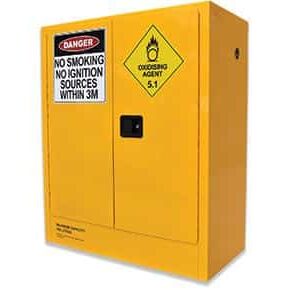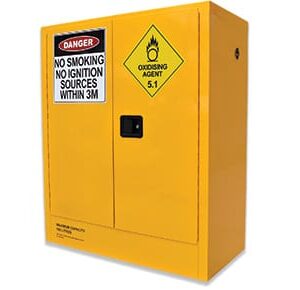Indoor Oxidising Agent Storage
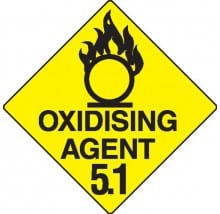
Features of our range of oxidising agent safety cabinets include; self-closing doors and, built in vents with flash arrestors, spill containment sump with drain and a yellow gloss lead-free epoxy/polyester powder-coat finish.
With sizes ranging from 30L (ideal for placing on or under work benches), to 250L capacity, we have the safety cabinets to meet your requirements.
Search Products:
Categories:
Showing all 5 results
-

30 Litre Indoor Oxidising Agents Cabinet
$1,325.00 + GST Add to cart -
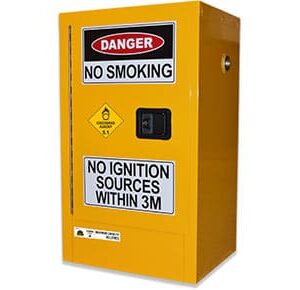
60 Litre Indoor Oxidising Agents Cabinet
$1,395.00 + GST Add to cart -
100 Litre Indoor Oxidising Agents Cabinet
$1,795.00 + GST Add to cart -
160 Litre Indoor Oxidising Agents Cabinet
$1,920.00 + GST Add to cart -
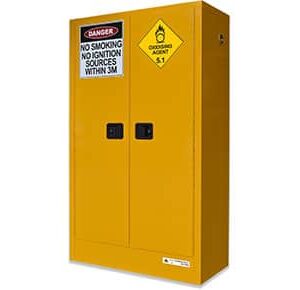
250 Litre Indoor Oxidising Agents Cabinet
$2,185.00 + GST Add to cart
Description
Oxidising agents are substances that can oxidise other substances or compounds. It has the ability to remove or separate hydrogen from another substance or compound. Examples of these oxidising agents include halogens, potassium nitrate, nitric acid, and organic peroxide, to name a few.
Oxidising Agents are classified as by themselves not combustible, but it can cause other substances to lose electrons, and by yielding oxygen, it may cause or contribute to combustion.
Failure to use the appropriate storage of oxidants may cause an oxidation reaction. This reaction produces heat, gas, and often it can ignite into flames. Spontaneous combustion present a danger not only to your property and personnel, but it can also impact the environment in the immediate area where these reactions occur.
The consequences that can result from such fires due to unsafe storage or negligence can range from property and equipment damage, environmental damage. People can get third-degree burns, or even possibly, death.
Accidents such as these can incur a high cost. Further, exposure by your personnel to such oxidising agents can be toxic if ingested, inhaled, or come into contact with skin and eyes. Furthermore, there are some oxidising agents that are also corrosive, which means they can damage metal, stone, and human flesh.
Class 5.1 Substances are required by law to comply with AS4326-2008, or The Storage and Handling of Oxidising Agents. Australian businesses using this substance must store these substances in fully compliant storage cabinets to prevent accidents from ever happening.
These standards were put in place to promote a high level of safety where these dangerous goods are stored or handled. These rules are outlined in AS4326-2008.

Features
Constructions:WSSA Indoor Oxidising Agent Storage Cabinets come in 30, 60, 100, 160, and 250 litre capacities are All-Australian Made and built for Australian conditions.
With sizes ranging from 30L (ideal for placing on or under work benches), to 250L capacity, we have the safety cabinets to meet your requirements.
All our Indoor Oxidising Agent Storage Cabinets meet and fully comply with AS4326-2008 – The Storage and Handling of Oxidising Agents.
1. Double-Wall Construction with 40mm Thermal Barrier and Vent Ports
2. Heavy-Duty Galvanised Steel Shelving for Enhanced Structural Integrity
3. Self-Closing Doors with Hydraulic Pressure Release for AS4326-2008 Compliance
4. Adjustable Feet for Stability on Uneven Surfaces
5. UV-Stabilized Thermosetting Powder Coat for Superior Corrosion Resistance
6. Self-Closing, Non-Lockable Doors for Optimal Safety in Various Cabinet Sizes
7. Superstructure Resistant to Melting Below 850°C for Enhanced Fire Safety
8. Perforated Floor and Spill Containment Sump for Effective Spill Management
9. Durable Powder-Coated Finish for Long-Lasting Protection Over Conventional Paint
10. Grounding Connector for Static Discharge Prevention and Fire Safety
Australian Standards
Businesses that handle and store oxidising agents should note that our line of Oxidising Agent Storage Cabinets are built for indoor use. Do note however that these line of storage cabinets are not configured and are not advised to be used to store Ammonium Nitrate.

Do note that under this rule, each cabinet must not exceed the permitted amount of oxidising agent. Also, the cabinets should be made in such a way to ensure that their contents are well-secured from any contamination from the outside that may cause risks of dangerous reaction.
